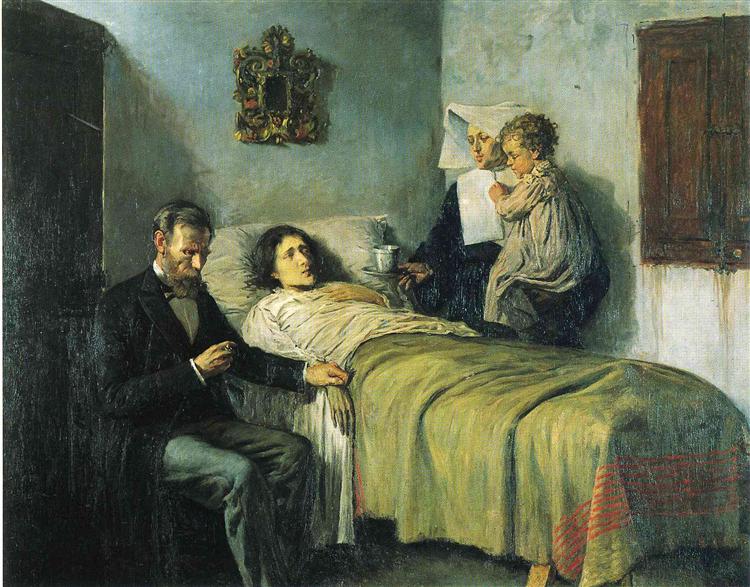Introduction:
“Science and Charity, 1897,” an early work by the prodigious Pablo Picasso, offers a unique window into the artist’s formative years and provides a captivating glimpse of his evolving artistic vision. Painted at the tender age of 15, this poignant composition reflects not only Picasso’s technical skill but also hints at the seeds of innovation and emotional depth that would come to define his revolutionary contributions to the world of art. In this exhaustive review, we will explore the historical context, thematic intricacies, artistic elements, and enduring impact of “Science and Charity, 1897.”
Section 1: Picasso’s Formative Years
Pablo Picasso’s early life in Barcelona, Spain, was marked by an insatiable curiosity and a prodigious talent that set him apart from his peers. Born in 1881, Picasso exhibited a remarkable aptitude for drawing from a young age, receiving formal training under his father, a drawing master. “Science and Charity, 1897” stands as a testament to the burgeoning artistic prowess of the teenage prodigy.
Section 2: The Historical Landscape
The late 19th century was a period of profound artistic and societal change. The emergence of avant-garde movements, such as Symbolism and Art Nouveau, challenged traditional artistic norms. Picasso, influenced by these currents and the burgeoning Symbolist movement, began to experiment with styles that conveyed emotional and psychological depth. “Science and Charity, 1897” bears the imprint of these influences, hinting at the burgeoning modernist sensibilities that would define Picasso’s later work.
Section 3: The Composition and Symbolism
“Science and Charity, 1897” is a narrative tableau that unfolds within a domestic setting. The painting captures a poignant scene wherein a physician attends to a sick child, while a woman, presumably the child’s mother, looks on. The composition is characterized by its stark contrast between light and shadow, a technique that foreshadows Picasso’s later exploration of Cubism. The symbolism embedded in the narrative invites viewers to contemplate themes of compassion, suffering, and the interplay between science and humanity.
Section 4: The Influence of Symbolism
The Symbolist movement, with its emphasis on evoking emotions and expressing subjective experiences, left an indelible mark on Picasso’s early work. “Science and Charity, 1897” reflects the Symbolist penchant for imbuing everyday scenes with allegorical and emotional resonance. The intermingling of themes related to science, compassion, and human connection underscores Picasso’s burgeoning engagement with broader philosophical and social concerns.
Section 5: Picasso’s Technical Mastery
Despite his youth, Picasso’s technical mastery is evident in the meticulous execution of “Science and Charity, 1897.” The precision with which he renders the figures, the play of light and shadow, and the subtle details in the facial expressions of the characters reveal an early virtuosity that belies his age. Picasso’s ability to capture the emotional nuances of the scene foreshadows the expressive power that would define his later works.
Section 6: Emotional Resonance
“Science and Charity, 1897” resonates emotionally through its portrayal of the compassionate act of tending to a sick child. The juxtaposition of the medical practitioner and the concerned mother creates a dynamic tension, prompting viewers to reflect on the symbiotic relationship between science and human empathy. The emotional depth imbued in the composition reveals Picasso’s sensitivity to the human condition even in his formative years.
Section 7: Paving the Way for Modernism
While “Science and Charity, 1897” may not overtly display the groundbreaking innovations associated with Picasso’s later Cubist period, it nonetheless serves as a crucial stepping stone toward modernism. The emphasis on emotional content, the departure from strict realism, and the exploration of new narrative possibilities in art lay the groundwork for the revolutionary transformations that would characterize Picasso’s later career.
Section 8: The Influence of Social Realism
The painting also bears traces of Social Realism, a movement that sought to depict the harsh realities of contemporary life. The emphasis on depicting scenes from everyday existence, as well as the exploration of themes related to poverty and societal challenges, aligns with the principles of Social Realism. Picasso’s early engagement with such themes hints at his evolving social consciousness.
Section 9: Educational Significance
“Science and Charity, 1897” holds educational significance, offering art enthusiasts, scholars, and students a valuable glimpse into the early artistic development of one of the 20th century’s most influential figures. Its inclusion in art history curricula allows for a deeper understanding of Picasso’s trajectory and the broader artistic landscape of the late 19th century.
Section 10: Conservation and Display
Currently housed at the Museu Picasso in Barcelona, “Science and Charity, 1897” enjoys a curated space that allows visitors to engage with the painting in its historical and artistic context. Conservation efforts ensure the preservation of this early masterpiece, allowing future generations to appreciate the nuances of Picasso’s formative years.
Section 11: The Evolution of Picasso’s Artistic Vision
“Science and Charity, 1897” offers a fascinating lens through which to trace the evolution of Picasso’s artistic vision. The painting’s emotional resonance, thematic complexity, and departure from strict realism foreshadow the radical innovations that would redefine the boundaries of artistic expression in the 20th century.
Section 12: Conclusion – A Glimpse into Picasso’s Artistic Genesis
In conclusion, “Science and Charity, 1897” stands as a captivating testament to the early genius of Pablo Picasso. This humble yet profound painting, created when the artist was just 15 years old, foreshadows the revolutionary contributions that Picasso would make to the world of art. Its emotional depth, thematic complexity, and technical mastery underscore the enduring significance of this early masterpiece in the rich tapestry of Picasso’s illustrious career. Through “Science and Charity, 1897,” viewers are granted a privileged glimpse into the formative years of an artistic genius whose transformative impact would reverberate across the realms of art and culture for generations to come.
